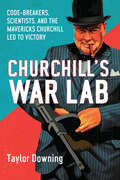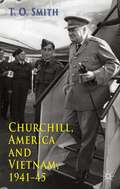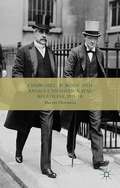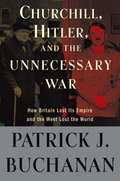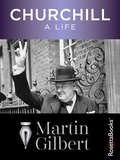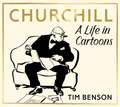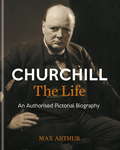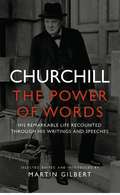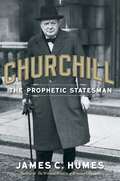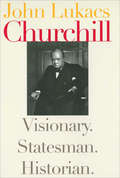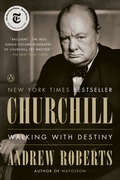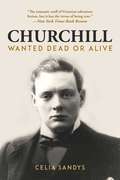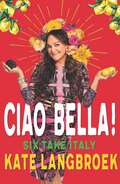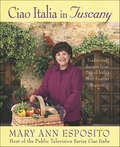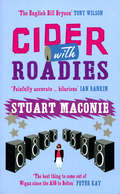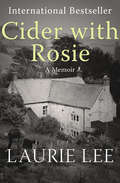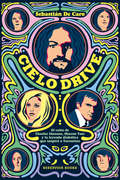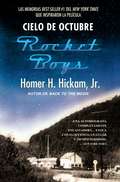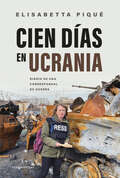- Table View
- List View
Churchill's War Lab: Code-breakers, Scientists, and the Mavericks Churchill Led to Victory
by Taylor DowningThe essential book on Churchill's passion for innovation and the science of war --from codes to radar to bouncing bombs. indefatigable patriot, seasoned soldier, incomparable orator, and, with Franklin Delano Roosevelt, leader of men --Winston Churchill's greatness in the allies' triumphant victory in World War ii is undisputed. yet, of his many unique qualities, Churchill's enduring legacy is attributable at least in equal part to his unshakeable fascination for the science of war. Churchill's War Lab reveals how Churchill's passion for military history, his inimitable leadership style, and his dedicated support of radical ideas would lead to new technologies and tactics that would enable an allied victory. no war generated more incredible theories, technical advances, and scientific leaps. from the development of radar and the decoding brilliance of Bletchley Park to the study of the D-Day beaches and the use of bouncing bombs, Churchill's War Lab is an exciting new take on Churchill as a complex, powerful, and inventive war leader. .
Churchill, America and Vietnam, 1941-45
by T. O. SmithPut in the wider context of British imperial and diplomatic aims in 1941-1945, the book clarifies the importance of Vietnam to Britain's regional objectives in Southeast Asia; concluding that Churchill was willing to sacrifice French colonial interests in Vietnam for his all-important 'special relationship' with the United States.
Churchill, Borden and Anglo-Canadian Naval Relations, 1911–14
by Martin ThorntonIn 1911, Winston S. Churchill and Robert L. Borden became companions in an attempt to provide naval security for the British Empire as a naval crisis loomed with Germany. Their scheme for Canada to provide battleships for the Royal Navy as part of an Imperial squadron was rejected by the Senate with great implications for the future.
Churchill, Hitler, and "The Unnecessary War": How Britain Lost Its Empire and the West Lost the World
by Patrick J. BuchananWere World Wars I and II--which can now be seen as a thirty-year paroxysm of slaughter and destruction--inevitable? Were they necessary wars? Were the bloodiest and most devastating conflicts ever suffered by mankind fated by forces beyond men's control? Or were they products of calamitous failures of judgment? In this monumental and provocative history, Patrick Buchanan makes the case that, if not for the blunders of British statesmen--Winston Churchill first among them--the horrors of two world wars and the Holocaust might have been avoided and the British Empire might never have collapsed into ruins. Half a century of murderous oppression of scores of millions under the iron boot of Communist tyranny might never have happened, and Europe's central role in world affairs might have been sustained for many generations.Among the British and Churchillian blunders were:* The secret decision of a tiny cabal in the inner Cabinet in 1906 to take Britain straight to war against Germany, should she invade France* The vengeful Treaty of Versailles that muti- lated Germany, leaving her bitter, betrayed, and receptive to the appeal of Adolf Hitler* Britain's capitulation, at Churchill's urging, to American pressure to sever the Anglo- Japanese alliance, insulting and isolating Japan, pushing her onto the path of militarism and conquest* The 1935 sanctions that drove Italy straight into the Axis with Hitler* The greatest blunder in British history: the unsolicited war guarantee to Poland of March 1939--that guaranteed the Second World War* Churchill's astonishing blindness to Stalin's true ambitions. Certain to create controversy and spirited argument, Churchill, Hitler, and "The Unnecessary War" is a grand and bold insight into the historic failures of judgment that ended centuries of European rule and guaranteed a future no one who lived in that vanished world could ever have envisioned.From the Hardcover edition.
Churchill: A Graphic Biography
by François Kersaudy Vincent Delmas“A wholly original and fresh approach to historical biography. Churchill would have been delighted to be a comic book hero!” —Phil Reed, Emeritus Director, Churchill War RoomsThis innovative graphic biography of Winston Churchill tells his extraordinary story, from his upbringing, through his military exploits and experience of the First World War, to his pivotal role in the Second World War. It explores the details of Churchill’s life within its historical and political context and brings the story to vivid life with precision, clarity and stunning visuals.With a foreword by Andrew Roberts, the biography is followed by extensive background information. Beautifully drawn, bursting with facts, and highly accessible, this graphic biography will introduce a new generation of readers to Churchill’s incredible career and important legacy.“This biography presents Churchill’s part in this conflict in a detailed yet inventive manner, making this accessible for people of all ages and knowledge.” —Comic-Watch“A highly original approach, using the comic strip style to tell his story. With magnificent artwork and a lively text, and a foreword by the historian and biography Andrew Roberts, it captures all the drama and excitement of his long life up to the victory over Nazi Germany.” —Leo McKinstry, author of Attlee and Churchill“A full and wholly fair representation of the most adventurous life in the history of British politics . . . there is not a word I would have changed in the text of this excellent graphical account.” —Andrew Roberts, New York Times-bestselling author of Churchill: Walking with Destiny“A novel and riveting re-telling of the Churchill legend.” —Professor Gary Sheffield
Churchill: A Graphic Biography
by François Kersaudy Vincent Delmas“A wholly original and fresh approach to historical biography. Churchill would have been delighted to be a comic book hero!” —Phil Reed, Emeritus Director, Churchill War RoomsThis innovative graphic biography of Winston Churchill tells his extraordinary story, from his upbringing, through his military exploits and experience of the First World War, to his pivotal role in the Second World War. It explores the details of Churchill’s life within its historical and political context and brings the story to vivid life with precision, clarity and stunning visuals.With a foreword by Andrew Roberts, the biography is followed by extensive background information. Beautifully drawn, bursting with facts, and highly accessible, this graphic biography will introduce a new generation of readers to Churchill’s incredible career and important legacy.“This biography presents Churchill’s part in this conflict in a detailed yet inventive manner, making this accessible for people of all ages and knowledge.” —Comic-Watch“A highly original approach, using the comic strip style to tell his story. With magnificent artwork and a lively text, and a foreword by the historian and biography Andrew Roberts, it captures all the drama and excitement of his long life up to the victory over Nazi Germany.” —Leo McKinstry, author of Attlee and Churchill“A full and wholly fair representation of the most adventurous life in the history of British politics . . . there is not a word I would have changed in the text of this excellent graphical account.” —Andrew Roberts, New York Times-bestselling author of Churchill: Walking with Destiny“A novel and riveting re-telling of the Churchill legend.” —Professor Gary Sheffield
Churchill: A Life
by Martin Gilbert&“A richly textured and deeply moving portrait of greatness&” (Los Angeles Times). In this masterful book, prize-winning historian and authorized Churchill biographer Martin Gilbert weaves together the research from his eight-volume biography of the elder statesman into one single volume, and includes new information unavailable at the time of the original work&’s publication. Spanning Churchill&’s youth, education, and early military career, his journalistic work, and the arc of his political leadership, Churchill: A Life details the great man&’s indelible contribution to Britain&’s foreign policy and internal social reform. With eyewitness accounts and interviews with Churchill&’s contemporaries, including friends, family members, and career adversaries, it provides a revealing picture of the personal life, character, ambition, and drive of one of the world&’s most remarkable leaders. &“A full and rounded examination of Churchill&’s life, both in its personal and political aspects . . . Gilbert describes the painful decade of Churchill&’s political exile (1929–1939) and shows how it strengthened him and prepared him for his role in the &‘hour of supreme crisis&’ as Britain&’s wartime leader. A lucid, comprehensive and authoritative life of the man considered by many to have been the outstanding public figure of the 20th century.&” —Publishers Weekly &“Mr. Gilbert&’s job was to bring alive before his readers a man of extraordinary genius and scarcely less extraordinary destiny. He has done so triumphantly.&” —The New York Times Book Review
Churchill: A Life
by Martin Gilbert&“A richly textured and deeply moving portrait of greatness&” (Los Angeles Times). In this masterful book, prize-winning historian and authorized Churchill biographer Martin Gilbert weaves together the research from his eight-volume biography of the elder statesman into one single volume, and includes new information unavailable at the time of the original work&’s publication. Spanning Churchill&’s youth, education, and early military career, his journalistic work, and the arc of his political leadership, Churchill: A Life details the great man&’s indelible contribution to Britain&’s foreign policy and internal social reform. With eyewitness accounts and interviews with Churchill&’s contemporaries, including friends, family members, and career adversaries, it provides a revealing picture of the personal life, character, ambition, and drive of one of the world&’s most remarkable leaders. &“A full and rounded examination of Churchill&’s life, both in its personal and political aspects . . . Gilbert describes the painful decade of Churchill&’s political exile (1929–1939) and shows how it strengthened him and prepared him for his role in the &‘hour of supreme crisis&’ as Britain&’s wartime leader. A lucid, comprehensive and authoritative life of the man considered by many to have been the outstanding public figure of the 20th century.&” —Publishers Weekly &“Mr. Gilbert&’s job was to bring alive before his readers a man of extraordinary genius and scarcely less extraordinary destiny. He has done so triumphantly.&” —The New York Times Book Review
Churchill: A Life in Cartoons
by Tim Benson'A welcome and important addition to this genre—especially given that it contains more than 300 cartoons, most of which have not been utilised in previously published books . . . With great skill Benson has created a highly readable, entertaining, and politically insightful description for each cartoon . . . Buy and read this delightful book.' INTERNATIONAL CHURCHILL SOCIETY________________________________________________Following an unrivalled political career that spanned a remarkable sixty years and reached both the heights and the depths of political fortune, Sir Winston Churchill undoubtedly became the world's most caricatured politician of all time. From entering Parliament in 1900 through to his retirement in 1964, Winston Churchill in Cartoons will chart Churchill's illustrious and tumultuous political career through the work of leading cartoonists from around the world.Through these cartoons there developed very contrary views of Churchill; the glorious cigar-chomping wartime leader and the flawed politician. In America he was adored by cartoonists, while in Nazi Germany and in the post-war Soviet Union he was, unsurprisingly, painted as a bumbling buffoon. After his passing in 1965, great contemporary cartoonists including Peter Brookes, Steve Bell, Matt and Gerald Scarfe, continued to use him as a benchmark for the world leaders that followed.Featuring the work of the some of the greatest cartoonists of all time and providing a new perspective of an iconic figure, Winston Churchill in Cartoons will include the very best and wittiest portrayals of Churchill the glorious wartime leader, controversial politician, and emblematic British statesman.
Churchill: An authorised pictorial biography
by Max ArthurWhen Winston Spencer Churchill was born in 1874. No one could have predicted the path that lay ahead. But, as it turned out, from Winston's undistinguished academic career to his front-line experiences as a soldier and journalist whether in India, Sudan or Cuba, and during the Boer War or in the trenches of World War I; through his unparalleled political career with all its ups and downs; to his 'finest hour' leading Britain during World War II, he was never to be far from the world's attention.Now the boy, the soldier, the writer, the orator, the politician, the statesman and the family man are all brought to life in this absorbing illustrated book. Featuring both letters to 'Mama' from the homesick - but rebellious - schoolboy and telegrams to Stalin, it highlights some of the most gripping communications from the Churchill Archives. Facsimiles of hand-annotated speech notes are paired with fascinating memorabilia, such as the poster for the reward for his capture during the Boer War, a specimen of one of his infamous cigars, a favourite gramophone record and his Parliamentary despatch box. This book also showcases pictures from his family photograph collection, providing a more intimate portrait of Churchill the husband, the family man and even Churchill the animal lover. Exhaustively researched, Churchill: The Life includes previously unpublished images - such as Winston as a cadet at Harrow and his casket's final journey into Bladon cemetery - as well as rare images of him as a baby and specially shot artefacts from family archives.Together with his unique selection of images, acclaimed historian Max Arthur's evocative and insightful narrative text gets to the core of Winston's character, using his own words and those of some of those closest to him, to provide a comprehensive study of the man and his life. This is a stunning tribute to a remarkable man.
Churchill: The Power of Words
by Winston Churchill Martin GilbertThis book contains one hundred extracts from Winston Churchill's books, articles and speeches. They range from his memories of his schooldays, to his contributions to the debates on social policy and on war, his contributions in both world wars to the events and discourse, and his efforts after 1945 to see the world a better place. a"
Churchill: The Prophetic Statesman
by James C. Humes John Spencer-ChurchillWho could have foreseen the start of World War I twenty-five years before the assassination of a Serbian archduke plunged Europe into war? Who could have predicted the rise of al-Qaeda nearly eight decades before anyone had heard of Osama bin Laden? <P><P> Winston Churchill did. And for the first time bestselling author James C. Humes reveals these and other shocking predictions from the famous British leader, in his new book Churchill: The Prophetic Statesman. As a skilled historian, Churchill didn't need a crystal ball to tell the future. <P><P>He studied patterns of the past which led to his eerily accurate forecasts, including: the rise of a Hitler-like figure along with Nazi Germany the year the Iron Curtain would fall and the Cold War would end the exact day of his own death as he entered his final years <P><P>In fascinating detail, Churchill: The Prophetic Statesman documents the spot-on prophecies Churchill foretold and the political consequences he endured for sharing them.
Churchill: Visionary. Statesman. Historian.
by John Lukacs&“Lukacs convincingly portrays a leader of an empire in irreversible decline and a towering, if flawed, hero of our time.&”—Publishers Weekly In previous works, John Lukacs told the story of Winston Churchill&’s titanic struggle with Adolf Hitler in the early days of World War II. Now, he turns his attention to the man himself, the workings of his historical imagination, and his successes and failures as a visionary statesman. Chapter by chapter, Lukacs assesses Churchill&’s vital relationships with Stalin, Roosevelt, and Eisenhower; his complex, farsighted political vision concerning the coming of WWII and the Cold War; his abilities as a historian looking backward into the origins of the conflicts of which he was so much a part; and the often contradictory ways in which he has been perceived by critics and admirers alike. In addition, Lukacs describes his three days spent in London attending Churchill&’s funeral in 1965. &“Superb…[a] tour de force.&”—Foreign Affairs &“Lukacs&’ ability to meld the scholarly with the popular is much in evidence here.&”—Booklist
Churchill: Walking with Destiny (Phoenix Giants Ser.)
by Andrew RobertsIn this landmark biography of Winston Churchill based on extensive new material, the true genius of the man, statesman and leader can finally be fully seen and understood--by the bestselling, award-winning author of Napoleon and The Storm of War <p><p> When we seek an example of great leaders with unalloyed courage, the person who comes to mind is Winston Churchill: the iconic, visionary war leader immune from the consensus of the day, who stood firmly for his beliefs when everyone doubted him. But how did young Winston become Churchill? What gave him the strength to take on the superior force of Nazi Germany when bombs rained on London and so many others had caved? In Churchill, Andrew Roberts gives readers the full and definitive Winston Churchill, from birth to lasting legacy, as personally revealing as it is compulsively readable. <p> Roberts gained exclusive access to extensive new material: transcripts of War Cabinet meetings, diaries, letters and unpublished memoirs from Churchill's contemporaries. The Royal Family permitted Roberts--in a first for a Churchill biographer--to read the detailed notes taken by King George VI in his diary after his weekly meetings with Churchill during World War II. This treasure trove of access allows Roberts to understand the man in revelatory new ways, and to identify the hidden forces fueling Churchill's legendary drive. <p> We think of Churchill as a hero who saved civilization from the evils of Nazism and warned of the grave crimes of Soviet communism, but Roberts's masterwork reveals that he has as much to teach us about the challenges leaders face today--and the fundamental values of courage, tenacity, leadership and moral conviction. <P><b>A New York Times Bestseller</b>
Churchill: Wanted Dead or Alive
by Celia SandysThe Extraordinary Story of a Young Winston Churchill in the Boer War, as Told by His Granddaughter In this lively biography of a dashing, brash twenty-five-year-old Churchill, Celia Sandys chronicles her celebrated grandfather’s adventures as a correspondent and combatant during nine months of the Anglo-Boer War—events that took him from the bivouacs and battle sites of Transvaal to his incarceration as a prisoner of war in Pretoria and ultimately to a bold escape across the border into Mozambique. Using both British and South African sources of testimony, which reveal the dauntless Winston alternately as a courageous ally or foolhardy foe, Sandys recounts the exploits of a Churchill that history has largely forgotten. With historical authority, narrative vigor, and singular charm, she offers both a fully drawn portrait of the ready adventurer who would become England’s legendary prime minister and an illuminating account of the turbulent events that defined South Africa for modern times.
Ciao Bella!: Six Take Italy
by Kate LangbroekKate Langbroek&’s deliciously funny and inspiring memoir about moving to Italy with her family to seek la dolce vita. &‘A wonderful story, beautifully written, filled with heart and humour&’ Liane Moriarty (reviewing Ciao Bella! on 3pm Pick Up, KIIS 1065)I wasn&’t looking to fall in love. It just happened. There were moments, encounters as fleeting as feelings. Sometimes – tellingly – they emerged from chaos. When Kate Langbroek first dreamed of moving to Italy, she imagined a magnificent sun-drenched pastiche of long lunches and wandering through cobbled laneways clutching a loaf of crusty bread and a bottle of wine, Sophia Loren-style, while handsome men called out &‘Ciao Bella!&’ In the stark light of day the dream Kate shared with her husband Peter after an idyllic holiday in Italy seemed like madness. They didn&’t speak Italian. They knew no one in Italy. They had four children. Kate also had the best job in the world on a top-rating radio show with her longtime friend, Dave Hughes. But the siren song of Italy was irresistible. This would be the adventure of a lifetime, a precious opportunity to spend more time with their children – Lewis, Sunday, Artie and Jannie – and it came from a deep well inside to seize life after they almost lost Lewis to leukaemia. Ciao Bella! is about having a dream and living it as Kate shares the sublime joys and utter chaos of adapting to a new life in Bologna, what you discover about yourself when you are a stranger in a strange land, and how she fell in love. With a country. Deliciously funny, insightful and often deeply moving, Ciao Bella! is Kate&’s love letter to Italy and her family. It is also a glorious reminder of what Italians can teach us about living life to the full – and what really matters when the world goes to hell in a handbasket.
Ciao Italia in Tuscany: Traditional Recipes from One of Italy's Most Famous Regions (Ciao Italia Ser.)
by Mary Ann EspositoFamed for its bustling cities rich with art, history, and centuries-old traditions, as well as for its gently rolling landscapes filled with vineyards, cypress trees, and olive groves, Tuscany is one of the most popular regions in Italy. Mary Ann Esposito, host of the longest-running television cooking show, invites us to experience the tastes, smells, and traditions of this wonderful region, one delectable meal at time.With eighty delicious recipes accompanied by anecdotes, travel essays, and cooking tips and techniques, this collection shares and explores the essence of Tuscan cooking. Cucina povera, country-style cooking, is the backbone of the Tuscan culinary heritage, and you'll see it in practice on an agricultural estate just outside of Siena, at a palazzino in the heart of Florence, at a popular restaurant in an industrial city, in medieval villages, and in the charming cities and towns across the region.Simple, flavorful ingredients are transformed into authentic, mouth-watering dishes such as Scarola e Fagioli (Escarole and Beans), Pappa al Pomodoro (Tomato Bread Soup), Patate con Olio e Ramerino (Potatoes with Olive Oil and Rosemary), Bistecca alla Fiorentina (Grilled T-bone Steak), Gnocchi di Patate con Salsa di Pecorino e Panna (Potato Gnocchi with Pecorino Cream Sauce), Panforte, Ricciarelli di Siena (Siena-Style Almond Cookies), and much more.Complete with information on mail-order sources, Web sites, and Tuscan restaurants, this celebration of the region of Tuscany is a tribute to the people practicing and preserving its rich culinary traditions.
Cicero: The Life and Times of Rome's Greatest Politician
by Anthony Everitt"All ages of the world have not produced a greater statesman and philosopher combined."--John AdamsHe squared off against Caesar and was friends with young Brutus. He advised the legendary Pompey on his somewhat botched transition from military hero to politician. He lambasted Mark Antony and was master of the smear campaign, as feared for his wit as he was for exposing his opponents' sexual peccadilloes. Brilliant, voluble, cranky, a genius of political manipulation but also a true patriot and idealist, Cicero was Rome's most feared politician, one of the greatest lawyers and statesmen of all times. Machiavelli, Queen Elizabeth, John Adams and Winston Churchill all studied his example. No man has loomed larger in the political history of mankind.In this dynamic and engaging biography, Anthony Everitt plunges us into the fascinating, scandal-ridden world of ancient Rome in its most glorious heyday. Accessible to us through his legendary speeches but also through an unrivaled collection of unguarded letters to his close friend Atticus, Cicero comes to life in these pages as a witty and cunning political operator.Cicero leapt onto the public stage at twenty-six, came of age during Spartacus' famous revolt of the gladiators and presided over Roman law and politics for almost half a century. He foiled the legendary Catiline conspiracy, advised Pompey, the victorious general who brought the Middle East under Roman rule, and fought to mobilize the Senate against Caesar. He witnessed the conquest of Gaul, the civil war that followed and Caesar's dictatorship and assassination. Cicero was a legendary defender of freedom and a model, later, to French and American revolutionaries who saw themselves as following in his footsteps in their resistance to tyranny. Anthony Everitt's biography paints a caustic picture of Roman politics--where Senators were endlessly filibustering legislation, walking out, rigging the calendar and exposing one another's sexual escapades, real or imagined, to discredit their opponents. This was a time before slander and libel laws, and the stories--about dubious pardons, campaign finance scandals, widespread corruption, buying and rigging votes, wife-swapping, and so on--make the Lewinsky affair and the U.S. Congress seem chaste.Cicero was a wily political operator. As a lawyer, he knew no equal. Boastful, often incapable of making up his mind, emotional enough to wander through the woods weeping when his beloved daughter died in childbirth, he emerges in these pages as intensely human, yet he was also the most eloquent and astute witness to the last days of Republican Rome.On Cicero:"He taught us how to think."--Voltaire"I tasted the beauties of language, I breathed the spirit of freedom, and I imbibed from his precepts and examples the public and private sense of a man." --Edward Gibbon"Who was Cicero: a great speaker or a demagogue?" --Fidel CastroFrom the Hardcover edition.
Cider With Roadies
by Stuart MaconieCider with Roadies is the true story of a boy's obsessive relationship with pop. A life lived through music from Stuart's audience with the Beatles (aged 3); his confessions as a pubescent prog rocker; a youthful gymnastic dalliance with northern soul; the radical effects of punk on his politics, homework and trouser dimensions; playing in crap bands and failing to impress girls; writing for the NME by accident; living the sex, drugs (chiefly lager in a plastic glass) and rock and roll lifestyle; discovering the tawdry truth behind the glamour and knowing when to ditch it all for what really matters.From Stuart's four minutes in a leisure centre with MC Hammer to four days in a small van with Napalm Death it's a life-affirming journey through the land where ordinary life and pop come together to make music.
Cider with Rosie: A Memoir (The Autobiographical Trilogy #1)
by Laurie LeeThis international-bestselling memoir of childhood in post–World War I rural England is one of the most &“remarkable&” portraits of youth in all literature (The New York Times). Three years old and wrapped in a Union Jack to protect him from the sun, Laurie Lee arrived in the village of Slad in the final summer of the First World War. The cottage his mother had rented for three and sixpence a week had neither running water nor electricity, but it was surrounded by a lovely half-acre garden and, most importantly, it was big enough for the seven children in her care. It was here, in a verdant valley tucked into the rolling hills of the Cotswolds, that Laurie Lee learned to look at life with a painter&’s eye and a poet&’s heart—qualities of vision that, decades later, would make him one of England&’s most cherished authors. In this vivid recollection of a magical time and place, water falls from the scullery pump &“sparkling like liquid sky.&” Autumn is more than a season—it is a land eternally aflame, like Moses&’s burning bush. Every midnight, on a forlorn stretch of heath, a phantom carriage reenacts its final, wild ride. And, best of all, the first secret sip of cider, &“juice of those valleys and of that time,&” leads to a boy&’s first kiss, &“so dry and shy, it was like two leaves colliding in air.&” An instant classic when it was first published in 1959, Cider with Rosie is one of the most endearing and evocative portraits of youth in all of literature. The first installment in an autobiographical trilogy that includes As I Walked Out One Midsummer Morning and A Moment of War, it is also a heartfelt and lyrical ode to England, and to a way of life that may belong to the past, but will never be forgotten.
Cielo Drive: El culto de Charles Manson, Sharon Tate y la leyenda diabólica que inspiró a Tarantino
by Sebastián De CaroA cincuenta años de los crímenes del Clan Manson, un original recorrido por su historia y su huella en la cultura pop; en particular, el cine (y la nueva película de Tarantino), la música y la literatura, con entrevistas a escritores y periodistas y una mirada absolutamente inédita sobre un personaje diabólico que obsesionó a varias generaciones. El 9 de agosto de 1969 varios miembros del Clan Manson, conocido como "La Familia", ingresaron a la casa ubicada en el 10050 de Cielo Drive, California, y asesinaron a puñaladas a cuatro personas. Entre ellas se encontraba Sharon Tate, la esposa embarazada del cineasta Roman Polanski. Al día siguiente el Clan prosiguió su brutal raid criminal, dando muerte al matrimonio de Leno y Rosemary LaBianca. Medio siglo más tarde la huella que estos crímenes imprimieron en la memoria colectiva y en la cultura popular ha inspirado infinidad de canciones, textos y películas documentales y de ficción. Pero, lejos de la trivia que abunda en internet, lo que se propone Sebastián De Caro en su nuevo libro no es reiterar la truculenta cronología, sino emprender un viaje enteramente nuevo a través de recuerdos y obsesiones personales disparados por este relato satánico. En compañía de un conjunto notable de escritores (Carlos Busqued y Mariana Enriquez), periodistas culturales (Alfredo Rosso, Darío Lavia, Juan Manuel Domínguez) y músicos (Nekro, Marcelo Pocavida y Mariano Roger, el guitarrista de Babasónicos), lleva adelante un recorrido digresivo e imprevisible, repleto de conexiones inesperadas, que aspira a reconstruir no tanto el escenario de los hechos como el clima de una época; el universo social y cultural que los hizo posibles y los volvió tan significativos. Finalmente, este libro puede también leerse como una lista de objetos y relatos por descubrir o a los cuales volver, así como una entusiasta guía para acercarse a la película de Quentin Tarantino, Había una vez en Hollywood, la cual, convertida en uno de los eventos cinematográficos del año, prueba que el interés en este cuento diabólico se mantiene absolutamente vigente cincuenta años después.
Cielo de octubre (Rocket Boys)
by Homer HickamAsí comienza la maravillosamente entretenida y extraordinaria autobiografía de la vida de «Sonny» Homer Hickam, Jr. en Coalwood, Virginia Occidental, un pueblo miserable donde lo único que importaba era la minería de carbón y el fútbol americano. El segundo hijo introspectivo del superintendente de la mina y de una madre decidida a alcanzar una vida mejor para su hijo, Sonny se unió a un grupo de inadaptados para quienes el futuro parecía incierto. Pero en 1957, luego de haber visto el satélite soviético Sputnik cruzar el cielo de los Apalaches, Sonny y sus amigos adolescentes tomaron el futuro en sus manos, cambiando sus vidas y su ciudad para siempre.Recordando una carrera distinguida en la NASA que hizo realidad los sueños de su niñez, Hickam relata la historia de su juventud, llevando a los lectores a la vida de aquel pueblo minero y las de los muchachos que encarnaron sus tensiones y sus sueños. Con la ayuda —y en ocasiones los obstáculos— de los habitantes de Coalwood, los jóvenes aprendieron no solo a convertir escombros de minería en cohetes que surcaban los cielos, sino que encontraron esperanza en una ciudad en la que el progreso pasaba desapercibido.Una autobiografía única, Cielo de octubre es a la vez una crónica inspiradora de triunfo y una historia luminosa del amor de una madre, los temores de un padre y la vida de un joven.Con la sencilla gracia de un narrador por naturaleza, Homer Hickam capta a la perfección un momento en el cual un pueblo agonizante, una familia dividida y una banda de adolescents soñadores se atrevieron a mirar más allá de sus diferencias y a fijar sus objetivos en las estrellas... y vieron un futuro que la nación estaba apenas empezando a imaginar.
Cien días en Ucrania: Diario de una corresponsal de guerra
by Elisabetta PiquéGestado sobre el terreno en medio de sirenas y explosiones, el libro desnuda las historias de desasosiego de la gente común detrás de una guerra que marcará un antes y un después en los equilibrios geopolíticos del mundo. El colega italiano me pregunta si quiero sumarme a una lista de personas a evacuar que está preparando el consulado de Italia.Le agradezco, pero no. No tengo ninguna duda de que voy a quedarme en Kiev. acabo de llegar y quiero contar esta historia. Elisabetta Piqué fue la primera periodista en llegar al lugar exacto donde comenzaron a llover las bombas y los misiles que iniciaron la invasión rusa a Ucrania. Durante los cien días que totalizaron sus tres estadías en la zona de conflicto, además de informar como corresponsal de La Nación, se dedicó a documentar su experiencia cotidiana y a recoger las voces de víctimas y testigos anónimos. Gestado en terreno, en medio de sirenas y explosiones, este libro desnuda las historias de desasosiego de la gente común detrás de la guerra que está marcando un antes y un después en los equilibrios geopolíticos del mundo y, al mismo tiempo, permite asomar a la experiencia personal y sensible de una periodista en el peligroso frente de batalla. Testimonio de primera mano tan crudo y original como reflexivo y bien narrado, Cien días en Ucrania pone al descubierto los aspectos más tangibles y concretos de la vida en medio de una guerra distinta que se libra en el corazón de Europa y en las redes sociales, involucra a todo el planeta y no tiene fin a la vista.
